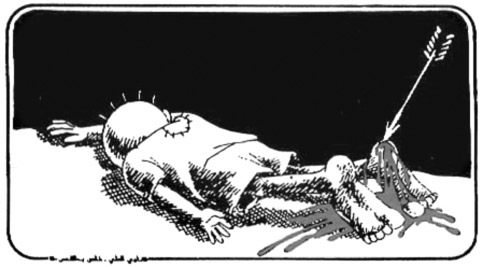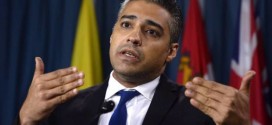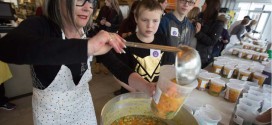By Arjan El Fassed– The Electronic Intifada
On Wednesday July 22 1987 at five in the afternoon, Palestinian cartoonist Naji Al-Ali parked his car in southwest London, and walked a few meters towards the offices of the Kuwaiti newspaper Al-Qabas where he worked. He was shot in the head by a gunman, dressed in a denim jacket, who walked calmly away down Draycott, near Sloane Square and vanished.
One of the first on the scene was Andre Muller, aged 27, of Putney, who was working in the Peter Jones store adjacent to Ives Street. He was summoned to the scene because of his first-aid skills. He said: “I felt his pulse to see if he was breathing and a few minutes later the police came along and told me to stay with him.”
After five weeks in a coma on a life support machine at St Stephen’s hospital and the neurosurgical department of Charing Cross hospital in London, Naji al-Ali died at 5am on Saturday, August 30, 1987 at the age of 49.
“I created this character to symbolize my lost childhood,” Naji Al-Ali
“I created this character to symbolize my lost childhood,” Naji Al-Ali
A friend of Naji al-Ali was quoted saying that he had been warned his life was in danger in a telephone call from a senior member of the PLO in Tunis. The telephone call, two weeks before the murder, came after the publication of a cartoon attacking a female friend of PLO leader Yasser Arafat. “The cartoon was famous in the Arab community,” the friend said. The caller said: “You must correct your attitude.”
“Don’t say anything against the honest people, otherwise we will have business to sort you out,” the caller continued. Naji al-Ali ignored the warning and published a cartoon lampooning Arafat and his henchmen on 24 June.
 Naji al-Ali came to London in 1985. He was married and had five children. The editor of Al-Qabas, who was quoted in the London Times said that Naji al-Ali had received more than a hundred death threats over the years. “I don’t know who could be responsible because he has been a critic of so many groups. But because of the way things are in Arab politics, nothing surprises me,” he said. “Our paper is an independent one and is not a strong critic of any particular group, so I cannot see why there should be an attack on us. I think it was meant as a direct attack on him.”
Naji al-Ali came to London in 1985. He was married and had five children. The editor of Al-Qabas, who was quoted in the London Times said that Naji al-Ali had received more than a hundred death threats over the years. “I don’t know who could be responsible because he has been a critic of so many groups. But because of the way things are in Arab politics, nothing surprises me,” he said. “Our paper is an independent one and is not a strong critic of any particular group, so I cannot see why there should be an attack on us. I think it was meant as a direct attack on him.”
In an article in Middle East International (10 October 1987), Professor Hisham Sharabi of Georgetown University wrote:
“Who is responsible for the murder of Naji al-Ali? Who is responsible for the murder of tens of Palestinians — we all know who they are — who paid for their freedom of conscience with their lives?”
“It was our silence and our fear that made us accept without protest the curtailment of free discussion and to allow terrorism to determine the way our differences are settled. History has shown that when liberation movements stifle liberty they become incapable of carrying out the task of liberation; they close in upon themselves and blindly submit to violence. There is in the murder of Naji al-Ali a lesson, which if we fail to understand we will lose the ability to liberate ourselves and to determine our destiny […] Without free and uninhibited debate, the achievement potential the Palestinians have in all fields will continue to be repressed or wasted, and with it their ability to confront and solve their problems. If the catastrophe toward which the Palestinians now seem to be heading is allowed to occur, they will have no one to blame but themselves.”
 The Arab Democrat The Latest From The Arab World
The Arab Democrat The Latest From The Arab World








